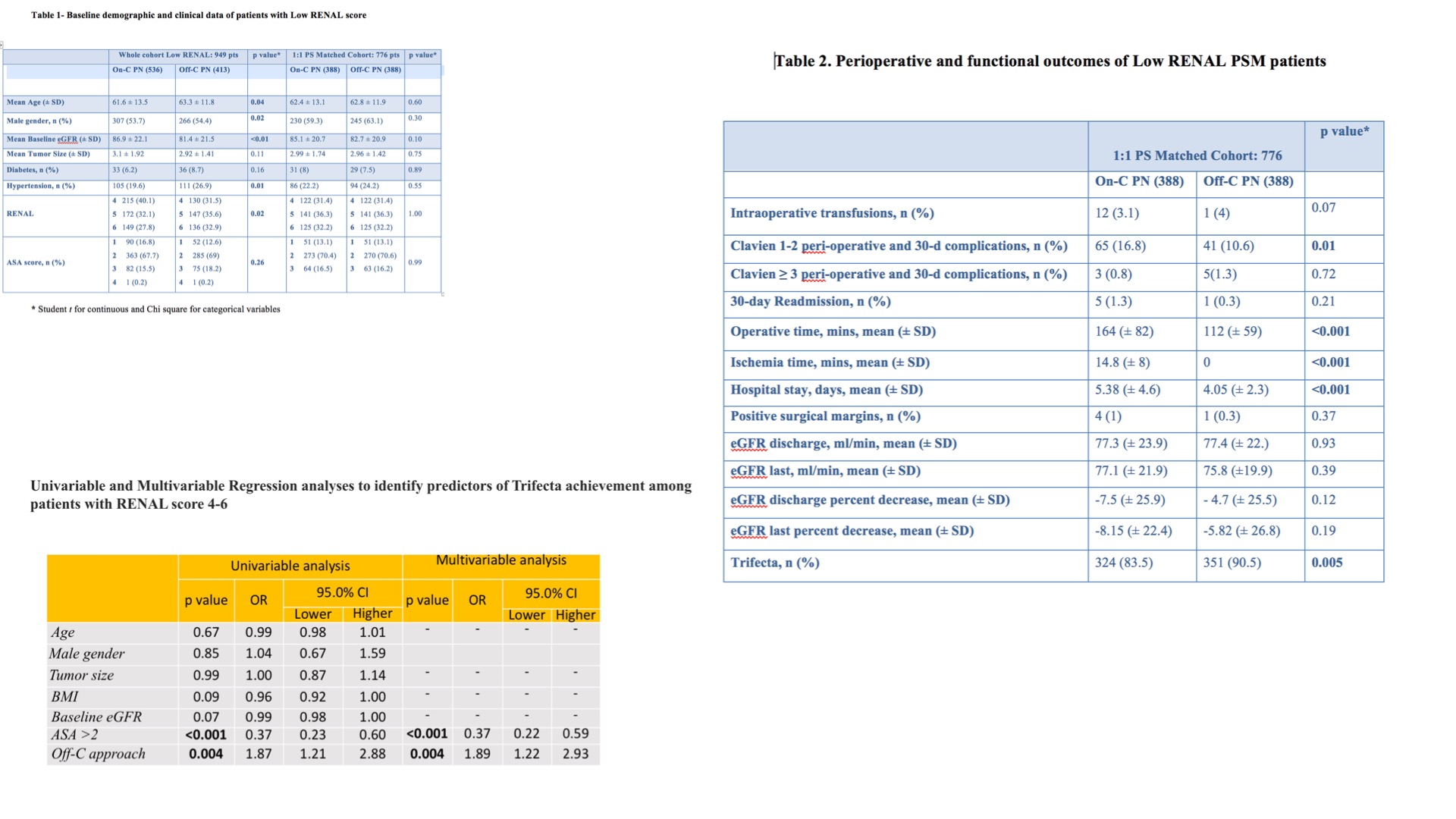Back
Poster, Podium & Video Sessions
Moderated Poster
MP50: Kidney Cancer: Localized: Surgical Therapy III
MP50-16: Assessing the role of Off-clamp Robotic Partial Nephrectomy in the setting of low complexity renal tumors: Propensity score-matched analysis of a multicenter database
Sunday, May 15, 2022
4:30 PM – 5:45 PM
Location: Room 225
Gabriele Tuderti*, Riccardo Mastroianni, Umberto Anceschi, Alfredo Maria Bove, Aldo Brassetti, Mariaconsiglia Ferriero, Leonardo Misuraca, Salvatore Guaglianone, Rome, Italy, Riccardo Autorino, Richmond, VA, Ava Saidian, Ithaar Derweesh, John Perry, San Diego, La Jolla, CA, Andrea Mari, Andrea Minervini, Florence, Italy, Manuela Costantini, Michele Gallucci, Giuseppe Simone, Roma, Italy
- GT
Poster Presenter(s)
Introduction: On-clamp (On-C) is the standard option to manage renal hilum during Robotic Partial Nephrectomy (RPN). In this study, we aimed to assess the safety and the potential benefits of Off-clamp (Off-C) approach in the setting of low complexity renal tumors
Methods: A multicentric RPN dataset including 1604 cases treated at 3 Institutions between September 2003 and September 2021 was queried for “RENAL score <= 6”. Baseline, perioperative, and functional data were reported. A 1:1 propensity score-matched (PSM) analysis was used to minimize imbalances between Off-C and On-C cohorts for significant covariates (age, gender, baseline estimated Glomerular Filtration Rate, tumor size, diabetes, hypertension, RENAL score, ASA score). Chi-square e student t tests were used to compare categorical and continuous variables. Univariable and multivariable regression analysis were performed to identify the predictors of Trifecta achievement, defined as the coexistence of negative surgical margins, no Clavien = 3 complications and = 30% post-operative eGFR rate reduction.
Results: Overall, 949 patients were included (536 On-C and 413 Off-C). The PSM-selected cohorts of 388 patients did not differ for all baseline clinical covariates (p³0.10). On-C procedure was time consuming (p < 0.001), had significantly higher low-grade Clavien complications rate (16.8% vs 10.6%, p=0.01), with severe complications and positive margins rates comparable to Off-C (p=0.72 and p=0.37, respectively). Off-C approach turned into a significantly higher Trifecta achievement (90.5% vs 83.5%, p=0.005). Adjusted for significant covariates [ASA score = 3 (OR=0.37, 95% CI: 0.22 – 0.59)], patients receiving Off-C RPN had a 1.89-fold increased probability to achieve Trifecta (95% CI:1.22–2.93; p=0.04).
Conclusions: Off-C RPN deserves a role in the treatment of low complexity renal tumors. This approach simplifies surgery and reduces operative times without affecting safety and cancer control while providing optimization of perioperative surgical outcomes.
Source of Funding: none

Methods: A multicentric RPN dataset including 1604 cases treated at 3 Institutions between September 2003 and September 2021 was queried for “RENAL score <= 6”. Baseline, perioperative, and functional data were reported. A 1:1 propensity score-matched (PSM) analysis was used to minimize imbalances between Off-C and On-C cohorts for significant covariates (age, gender, baseline estimated Glomerular Filtration Rate, tumor size, diabetes, hypertension, RENAL score, ASA score). Chi-square e student t tests were used to compare categorical and continuous variables. Univariable and multivariable regression analysis were performed to identify the predictors of Trifecta achievement, defined as the coexistence of negative surgical margins, no Clavien = 3 complications and = 30% post-operative eGFR rate reduction.
Results: Overall, 949 patients were included (536 On-C and 413 Off-C). The PSM-selected cohorts of 388 patients did not differ for all baseline clinical covariates (p³0.10). On-C procedure was time consuming (p < 0.001), had significantly higher low-grade Clavien complications rate (16.8% vs 10.6%, p=0.01), with severe complications and positive margins rates comparable to Off-C (p=0.72 and p=0.37, respectively). Off-C approach turned into a significantly higher Trifecta achievement (90.5% vs 83.5%, p=0.005). Adjusted for significant covariates [ASA score = 3 (OR=0.37, 95% CI: 0.22 – 0.59)], patients receiving Off-C RPN had a 1.89-fold increased probability to achieve Trifecta (95% CI:1.22–2.93; p=0.04).
Conclusions: Off-C RPN deserves a role in the treatment of low complexity renal tumors. This approach simplifies surgery and reduces operative times without affecting safety and cancer control while providing optimization of perioperative surgical outcomes.
Source of Funding: none


.jpg)
.jpg)